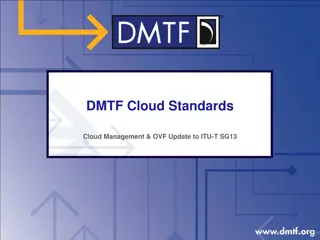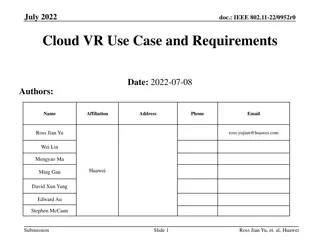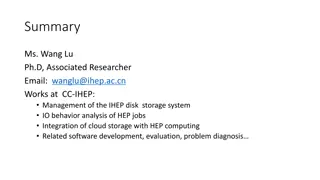
How to Optimize Performance in Cloud Data Management Systems
As businesses increasingly rely on cloud platforms for storing and managing their data, optimizing performance in cloud data management systems becomes critical.
Download Presentation

Please find below an Image/Link to download the presentation.
The content on the website is provided AS IS for your information and personal use only. It may not be sold, licensed, or shared on other websites without obtaining consent from the author. Download presentation by click this link. If you encounter any issues during the download, it is possible that the publisher has removed the file from their server.
E N D
Presentation Transcript
How to Optimize Performance in Cloud Data Management Systems As businesses increasingly rely on cloud platforms for storing and managing their data, optimizing performance in cloud data management systems becomes critical. Poor performance can lead to increased latency, inefficient resource usage, and higher costs. To get the most out of your cloud infrastructure, it s essential to implement strategies that maximize efficiency, speed, and scalability. Here are some key approaches to optimize the performance of cloud data management systems. 1. Choose the Right Cloud Provider and Tools The first step in optimizing cloud data management performance is selecting the right cloud service provider. Different providers offer varying levels of performance, scalability, and reliability. For instance, popular providers like AWS, Microsoft Azure, and Google Cloud offer different storage solutions, such as Amazon S3 or Azure Blob Storage, each with distinct capabilities and pricing models. It s essential to assess the specific requirements of your business and select a provider and tools that align with your data management goals. Consider factors such as: Data volume Expected traffic Cost efficiency Compliance requirements 2. Optimize Data Storage and Access Efficient data storage is crucial for performance. Consider these strategies for optimizing data storage in the cloud: Use Tiered Storage Solutions: Many cloud providers offer multiple storage tiers, from hot storage (for frequently accessed data) to cold storage (for infrequently accessed data). By categorizing your data based on access frequency, you can reduce costs while improving performance for frequently accessed files. Implement Caching: Caching can significantly enhance data access speeds by storing copies of frequently requested data closer to the user or application. Caching reduces the need to retrieve data from the primary database or storage system repeatedly, minimizing latency. Database Optimization: If your cloud system includes a database, optimize it for performance by indexing data, removing unused indexes, and partitioning large tables. Consider using managed database services like Amazon RDS or Google Cloud SQL for performance tuning and scalability. 3. Monitor and Optimize Resource Allocation One of the biggest advantages of cloud platforms is their elasticity resources can scale up or down based on demand. However, overprovisioning or underutilizing resources can lead to inefficiencies and increased costs.
Autoscaling: Enable autoscaling for computing resources such as virtual machines or containers. This ensures your infrastructure automatically scales during high-traffic periods and contracts when demand decreases, providing the right amount of resources at the right time. Monitor Performance Metrics: Use cloud provider tools or third-party services to monitor metrics like CPU utilization, memory usage, and network traffic. These insights will help you identify bottlenecks and optimize resource allocation accordingly. 4. Use Data Compression and Deduplication Data storage and transfer are major factors in cloud performance. Large datasets can slow down processes and increase storage costs. By applying data compression techniques, you can reduce the size of data files, speeding up data transfers and reducing storage usage. Compression: Before uploading files to the cloud, compress them to reduce their size. Most cloud storage services support file compression and decompression. Deduplication: Implement deduplication to eliminate redundant data copies. By storing only unique data, deduplication reduces storage requirements and improves retrieval times, especially in environments with large volumes of repetitive data. 5. Leverage Cloud-Native Services and Automation Cloud providers offer a range of cloud-native services designed to optimize performance without the need for extensive manual management. These services include: Content Delivery Networks (CDNs): CDNs, such as AWS CloudFront or Azure CDN, help reduce latency by distributing content across multiple geographic locations. This ensures users can access data from the server closest to their location. Serverless Computing: Using serverless functions like AWS Lambda or Azure Functions can help optimize performance by eliminating the need to manage underlying infrastructure. Serverless architectures automatically scale to meet demand and only consume resources when tasks are running, enhancing both efficiency and cost-effectiveness. Automation Tools: Automate routine cloud management tasks such as backups, updates, and data transfers using tools like AWS Lambda or Azure Logic Apps. This minimizes human error and ensures continuous optimization. 6. Ensure Data Security without Sacrificing Performance While security is essential in cloud environments, it should not come at the expense of performance. To maintain a balance: Use Encryption Wisely: Ensure that sensitive data is encrypted both in transit and at rest, but avoid over-encryption, which can introduce latency. Managed encryption services provided by cloud platforms are typically optimized for both security and performance. Implement Access Controls: Minimize access to your cloud resources to essential personnel. This limits unnecessary data access, ensuring faster processing times and reducing the risk of security breaches.
Conclusion Optimizing performance in cloud data management systems requires a multifaceted approach, focusing on resource management, storage efficiency, data security, and leveraging cloud-native services. By implementing these strategies, businesses can maximize the performance of their cloud infrastructure, reduce operational costs, and deliver a seamless experience for users and applications. With the growing reliance on cloud-based services, ensuring optimal performance is key to maintaining a competitive edge in today s digital landscape. Read More: https://techhorizonsolutions.blogspot.com/2024/09/how-to-optimize-performance-in- cloud.html
















































